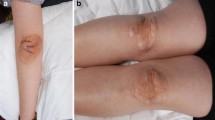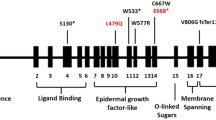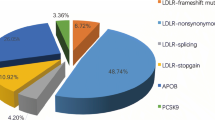Abstract
Familial hypercholesterolaemia (FH) is an autosomal dominant genetic disorder, associated with elevated level of serum low-density lipoprotein-cholesterol (LDL-C), which can lead to premature cardiovascular disease (CVD). Mutations in low density lipoprotein receptor (LDLR) and proprotein convertase subtilisin/kexin type 9 (PCSK9) have been identified to be the underlying cause of this disease. Genetic research of FH has already been extensively studied all over the world. However, reports of FH mutations in the Chinese population are still limited. In this paper, 20 unrelated FH families were enrolled to detect the candidate gene variants in Chinese FH population by DNA direct sequencing. We identified 12 LDLR variants in 13 FH probands. Importantly, we first reported two unique mutations (c.2000_2000 delG/p.C667LfsX6 and c.605T>C/p.F202S) in LDLR gene. Our discoveries expand the spectrum of LDLR mutations and contribute to the genetic diagnosis and counseling for FH patients.



Similar content being viewed by others
References
Lye, S. H., Chahil, J. K., Bagali, P., et al. (2013). Genetic polymorphisms in LDLR, APOB, PCSK9 and other lipid related genes associated with familial hypercholesterolemia in Malaysia. PLoS ONE, 8(4), e60729.
Hovingh, G. K., Davidson, M. H., Kastelein, J. J., & O'Connor, A. M. (2013). Diagnosis and treatment of familial hypercholesterolaemia. European Heart Journal, 34(13), 962–971.
Chiou, K. R., & Charng, M. J. (2012). Common mutations of familial hypercholesterolemia patients in Taiwan: characteristics and implications of migrations from southeast China. Gene, 498(1), 100–106.
Alicezah, M. K., Razali, R., Rahman, T., et al. (2014). Homozygous familial hypercholesterolemia. The Malaysian Journal of Pathology, 36(2), 131–137.
Mollaki, V., Progias, P., & Drogari, E. (2014). Familial hypercholesterolemia in Greek children and their families: genotype-to-phenotype correlations and a reconsideration of LDLR mutation spectrum. Atherosclerosis, 237(2), 798–804.
Mabuchi, H., Nohara, A., Noguchi, T., et al. (2014). Genotypic and phenotypic features in homozygous familial hypercholesterolemia caused by proprotein convertase subtilisin/kexin type 9 (PCSK9) gain-of-function mutation. Atherosclerosis, 236(1), 54–61.
Alves, A. C., Etxebarria, A., Soutar, A. K., Martin, C., & Bourbon, M. (2014). Novel functional APOB mutations outside LDL-binding region causing familial hypercholesterolaemia. Human Molecular Genetics, 23(7), 1817–1828.
Hooper, A. J., Nguyen, L. T., Burnett, J. R., et al. (2012). Genetic analysis of familial hypercholesterolaemia in Western Australia. Atherosclerosis, 224(2), 430–434.
Costelloe, S. J., El-Sayed, M. J. S., Drenos, F., et al. (2012). Gene-targeted analysis of copy number variants identifies 3 novel associations with coronary heart disease traits. Circulation. Cardiovascular Genetics, 5(5), 555–560.
Kathiresan, S., Voight, B. F., Purcell, S., et al. (2009). Genome-wide association of early-onset myocardial infarction with single nucleotide polymorphisms and copy number variants. Nature Genetics, 41(3), 334–341.
Chiu, C. Y., Wu, Y. C., Jenq, S. F., & Jap, T. S. (2005). Mutations in low-density lipoprotein receptor gene as a cause of hypercholesterolemia in Taiwan. Metabolism, 54(8), 1082–1086.
Al-Rasadi, K., Al-Waili, K., Al-Zidi, W. A., et al. (2014). Low-density lipoprotein receptor gene mutation analysis and structure-function correlation in an Omani Arab family with familial hypercholesterolemia. Angiology, 65(10), 911–918.
Dai, Y. F., Sun, L. Y., Zhang, X. B., & Wang, L. Y. (2011). Research progression of LDLR mutations in Chinese familial hypercholesterolemia. Yi Chuan, 33(1), 1–8.
Xiang, R., Fan, L. L., Huang, H., et al. (2013). A novel mutation of GATA4 (K319E) is responsible for familial atrial septal defect and pulmonary valve stenosis. Gene.
Sunyaev, S., Ramensky, V., & Bork, P. (2000). Towards a structural basis of human non-synonymous single nucleotide polymorphisms. Trends in Genetics, 16(5), 198–200.
Ng, P. C., & Henikoff, S. (2003). SIFT: predicting amino acid changes that affect protein function. Nucleic Acids Research, 31(13), 3812–3814.
Schwarz, J. M., Rodelsperger, C., Schuelke, M., & Seelow, D. (2010). MutationTaster evaluates disease-causing potential of sequence alterations. Nature Methods, 7(8), 575–576.
Robinson, J. G. (2013). Management of familial hypercholesterolemia: a review of the recommendations from the National Lipid Association Expert Panel on Familial Hypercholesterolemia. Journal of Managed Care Pharmacy, 19(2), 139–149.
Chang, J. H., Pan, J. P., Tai, D. Y., et al. (2003). Identification and characterization of LDL receptor gene mutations in hyperlipidemic Chinese. Journal of Lipid Research, 44(10), 1850–1858.
Mak, Y. T., Pang, C. P., Tomlinson, B., et al. (1998). Mutations in the low-density lipoprotein receptor gene in Chinese familial hypercholesterolemia patients. Arteriosclerosis, Thrombosis, and Vascular Biology, 18(10), 1600–1605.
Jørgensen, A. B., Frikke-Schmidt, R., et al. (2014). Loss-of-function mutations in APOC3 and risk of ischemic vascular disease. The New England Journal of Medicine, 371(1), 32–41.
Lange, L. A., Hu, Y., Zhang, H., et al. (2014). Whole-exome sequencing identifies rare and low-frequency coding variants associated with LDL cholesterol. The American Journal of Human Genetics, 94(2), 233–245.
Gent, J., & Braakman, I. (2004). Low-density lipoprotein receptor structure and folding. Cellular and Molecular Life Sciences, 61(19–20), 2461–2470.
Tan, Z. P., Xie, L., Deng, Y., et al. (2014). Whole-exome sequencing identifies Y1495X of SCN5A to be associated with familial conduction disease and sudden death. Scientific Reports, 4, 5616.
Mabuchi, H., Nohara, A., Noguchi, T., et al. (2011). Molecular genetic epidemiology of homozygous familial hypercholesterolemia in the Hokuriku district of Japan. Atherosclerosis, 214(2), 404–407.
Soufi, M., Rust, S., Walter, M., et al. (2013). A combined LDL receptor/LDL receptor adaptor protein 1 mutation as the cause for severe familial hypercholesterolemia. Gene, 521(1), 200–203.
Tosi, I., Toledo-Leiva, P., Neuwirth, C., et al. (2007). Genetic defects causing familial hypercholesterolaemia: identification of deletions and duplications in the LDL-receptor gene and summary of all mutations found in patients attending the Hammersmith Hospital Lipid Clinic. Atherosclerosis, 194(1), 102–111.
Bochem, A. E., Holleboom, A. G., Romijn, J. A., et al. (2014). Adrenal function in females with low plasma HDL-C due to mutations in ABCA1 and LCAT. PLoS ONE, 9(5), e90967.
Acknowledgments
We thank the patients and their families for participating in this study. We thank the Center of Clinical Gene Diagnosis and Therapy of the State Key Laboratory of Medical Genetics of China for technical assistance. This study was supported by the National Natural Science Foundation of China (81370394), the National Basic Research Program of China (973 Program) (2012CB517900), and the Fundamental Research Funds for Central Universities of Central South University (2014zzts284, 2014zzts086).
Conflict of Interest
None.
Author information
Authors and Affiliations
Corresponding authors
Additional information
Liang-liang Fan and Min-jie Lin contributed equally to this work.
Electronic Supplementary Material
Below is the link to the electronic supplementary material.
ESM 1
(DOC 46 kb)
Rights and permissions
About this article
Cite this article
Fan, Ll., Lin, Mj., Chen, Yq. et al. Novel Mutations of Low-Density Lipoprotein Receptor Gene in China Patients with Familial Hypercholesterolemia. Appl Biochem Biotechnol 176, 101–109 (2015). https://doi.org/10.1007/s12010-015-1554-x
Received:
Accepted:
Published:
Issue Date:
DOI: https://doi.org/10.1007/s12010-015-1554-x




